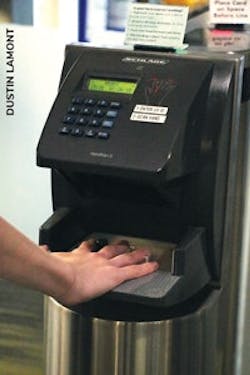Control Foot Traffic in Your Facility with Biometrics
Student Life & Wellness Center | Utah Valley University
Convenient Access Control
More facilities managers are turning to biometrics to streamline movement throughout their buildings. Learn how to leverage biometrics to optimize the flow of traffic with these two examples.
The Student Life & Wellness Center at Utah Valley University is a 175,000 square foot recreation center where students, faculty and staff can be active. The fitness center includes a 1/8-mile rubber indoor track, free weight areas, cardio equipment, fitness rooms, three basketball courts, a MAC Gym, a 40-foot climbing wall, and the six-lane bowling alley and gaming center.
With all of those amenities, there is a steady stream of traffic going in and out of the facility. The university wanted to improve incoming traffic and convenience while ensuring secure access control.
“The reason we went with biometric readers is for simplicity and convenience,” says DaSheek Akwenye, Director of Campus Recreation & Wellness at UVU. “With technology always evolving and changing, we found that students find it less convenient to carry their ID cards, and what better way to accommodate those that carry their ID cards less by utilizing their handprint to enter the facility?”
Since their implementation in April 2014, the turnstiles with biometric readers have been a big hit. They allow flexibility with daily operations because students can gain access to the building via student ID cards or using the hand readers.
Students primarily use the biometric hand scanners instead of their student IDs to gain access now. The readers reduce the headaches involved with students losing their cards, and alleviating stressors like this for students can complement success in the classroom.Once registered within the system, users merely need their hand to gain access. There have not been many technical difficulties with the biometric readers, but when there are, card readers provide reliable backup.
Related Content
Like any new technology that comes out, there’s always a learning curve to overcome, and sometimes there’s a user error that takes time for some users to know how to use the biometric hand readers,” says Akwenye. “We’ve had a few times where the software has gone offline, but the great thing about the turnstiles is that they are also equipped with card readers to provide secondary access.”
In addition to the convenience of quick and easy access to the facility, they do not take much time to set up. Those who want access simply need to fill out their membership application for processing and then to capture their handprint. Akwenye notes that it typically takes less than 2 minutes to finish the registration process.
TSA PreCheck | Atlanta and Denver
Fast and Precise Security
Lines at airport security only add to the inconvenience of air travel. In the summer of 2017, the Transportation Security Administration (TSA) employed the use of biometric readers in TSA PreCheck lanes at Hartsfield-Jackson Atlanta International Airport and at Denver International Airport.
The biometric readers in these lanes read passengers’ fingerprints to authenticate their identity, serving as both a boarding pass and identity document. Enrolled participants can voluntarily take part and can significantly reduce the complications of security checks.
“TSA looks at technologies and intelligence capabilities that allow us to analyze and secure the travel environment, passengers and their property,” says TSA Acting Assistant Administrator Steve Karoly of the Office of Requirements and Capabilities Analysis. “Through these and other technology demonstrations, we are looking to reinvent and enhance security effectiveness to meet the evolving threat and ensure that passengers get to their destinations safely.”
The hope for the TSA is to use this technology more widely after confirming its feasibility and security for this kind of traffic. While most facilities will never have this much traffic, buildings with higher security needs ought to take note of the program.
